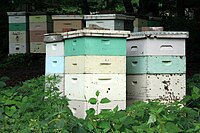

A beehive is an enclosed structure where some honey bee species of the subgenus Apis live and raise their young. Though the word beehive is used to describe the nest of any bee colony, scientific and professional literature distinguishes nest from hive. Nest is used to discuss colonies that house themselves in natural or artificial cavities or are hanging and exposed. The term hive is used to describe an artificial/man-made structure to house a honey bee nest. Several species of Apis live in colonies. But for honey production, the western honey bee (Apis mellifera) and the eastern honey bee (Apis cerana) are the main species kept in hives.[1][2]
The nest's internal structure is a densely packed group of hexagonal prismatic cells made of beeswax, called a honeycomb. The bees use the cells to store food (honey and pollen) and to house the brood (eggs, larvae, and pupae).
Beehives serve several purposes. These include producing honey, pollinating nearby crops, housing bees for apitherapy treatment, and mitigating the effects of colony collapse disorder. In America, hives are commonly transported so bees can pollinate crops elsewhere.[3] Several patents have been issued for beehive designs.
- ^ University of Florida - Apis cerana - http://entnemdept.ufl.edu/creatures/misc/bees/Apis_cerana.htm
- ^ University of Florida - Apis mellifera - http://entnemdept.ufl.edu/creatures/MISC/BEES/euro_honey_bee.htm
- ^ "Chapter 10 – Honey" (PDF). fs.fed.us. USDA. Archived from the original (PDF) on 5 July 2017. Retrieved 2 May 2018.